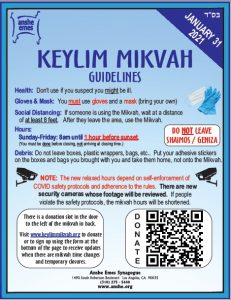Parsha Beshallach
A. Summary
1. The Jews Leave Egypt. When the Jews left Egypt, Hashem led them to Israel via an indirect route (i.e., not through the land of the hostile Philistines, lest they encounter hostile armies there and come to regret leaving Egypt). The Jews journeyed led by a pillar of cloud by day and a pillar of fire by night. (As Yoseph had been promised, Moshe brought along his remains for burial in Israel.) The Jews reached Etham on the wilderness’ edge and were commanded to turn back and camp by the Red Sea. There, Pharaoh would pursue them (thinking they were trapped), but Hashem assured them that He would again save them.
2. The Splitting of The Red Sea. Pharaoh immediately regretted letting the Jews leave and, accordingly, assembled his entire army to pursue them. When they were on the Jews’ heels, the Jews panicked and complained bitterly to Moshe, saying that “it would have been better for us to serve in Egypt than to die in the wilderness”. However, Moshe assured them that Hashem would again save them. The pillar of the cloud moved to the rear, creating a veil of darkness that hindered the Egyptian advance. At Hashem’s bidding, Moshe stretched out his hand over the Red Sea and a strong east wind blew and divided the waters, allowing the Jews to cross on dry land. The Egyptians attempted to follow them, but were thrown into confusion by Hashem, Who caused their chariot wheels to become stuck in the wet sand. Moshe then stretched out his hand over the sea, and waters drowned the Egyptians and their animals. Upon witnessing this miracle, the Jews collectively sung a song (“Az Yashir”) praising Hashem’s infinite power in destroying their enemy.
3. The Waters of Marah. The Jews continued their journey, reaching Marah (“bitterness”), so named because of its bitter waters. The people became thirsty and murmured against Moshe, who was shown a tree which when thrown into the waters made them sweet. The Jews refreshed themselves and continued on.
4. Manna From Heaven. One month after leaving Egypt, the Jews entered the wilderness of Sinai. Soon their lack of food made they wish they died amidst the “luxuries” in Egypt. Hashem made it known that He would cause bread to rain from heaven and would test whether the Jews obeyed His law. In the evening, quails came to the camp, providing the Jews with meat; in the morning, the ground was covered with Manna (which tasted like whatever its consumer desired). The Jews were commanded to each gather no more than an Omer (approximately four pints) of Manna per day; however, on the sixth day, they were told to gather a double portion so that they would have Manna on Shabbos, when work was prohibited. An Omer of Manna was placed before the Ark in the Mishkon (the tabernacle) as a testimonial to Hashem’s kindness.
5. The Jews Again Complain About The Lack Of Water. At Rephidim, the people again complained to Moshe about the lack of water. At Hashem’s bidding, Moshe struck the rock on nearby Mt. Horeb with his staff, causing streams of water to gush forth, and the people drank to their hearts’ content. The place where this miracle occurred was called Massah-Meriva.
6. The Tribe Of Amalek Attacks The Jews. At Rephidim, the tribe of Amalek, descendants of Esau, attacked the Jews. The Jews, led by Yehosuhua, fought back. While the war raged, Moshe (accompanied by Aharon and Chur) went to the top of the hill holding his staff. When he raised his hands in prayer to Hashem, the Jews prevailed. The battle lasted until sunset, when Amalek was decisively defeated. Moshe was told to record the incident and impress its occurrence upon Yehoshua (who would lead the Jews into Israel). Because of their treachery in attacking the Jews, the tribe of Amalek was to be totally destroyed and its memory eradicated.
B. Divrei Torah
1. Lilmode Ul’lamed (Rabbi Mordechai Katz)
a. The Miracle of The Red Sea/Unwavering Faith In Hashem. The Jews were terrified as they stood on the shores of the Red Sea watching the Egyptians advance. However, when the great Nachson ben Aminodov, fully confident that Hashem would save him, stepped forward and jumped into the waters, the waters parted. It was his unwavering faith in Hashem which led to this great miracle. Another example of such faith is Rabbi Shimon ben Gamliel, who disobeyed a decree against performing a Bris on his child. When the emperor heard that he had disobeyed the decree, he summoned him to trial. On the way, Rabbi Shimon and his wife befriended a noble aristocratic non-Jewish family, who had mercy on them and temporarily swapped babies so they could show the emperor that “their” son was uncircumcised. The charges were dismissed and their son grew up to be the great Rabbi Yehuda Hanassi.
b. Seeing Daily Miracles. Every Jew was ordered to collect only a set amount of Manna each day; whatever excess manna was taken (except on the sixth day) would rot, since whoever took any excess exhibited a lack of faith in Hashem. Whoever believes that Hashem will not come to the aid of the Jews in our time is equally wrong, for our continued existence, the miracles of nature and many other world events constantly evidence Hashem’s enduring assistance. However, like the Jews in the desert, we too often them take the daily miracles for granted. We must take the time to appreciate all of the marvels of Hashem’s nature and to perceive that miracles are constantly happening around us.
2. Growth Through Torah (Rabbi Zelig Pliskin)
a. Only by mastering your thoughts will you truly experience freedom in your life. “And on that day the Almighty saved the Jews from the hand of Egypt”. The Ohr Hachayim notes that the Jews were not considered free until the Egyptians drowned in the Red Sea. We learn from this that a person isn’t free until he/she personally feels free. A person who worries and feels insecure remains imprisoned. To be free, one must gain control over one’s thoughts and worrying. For if one worries about the future, even if events turn out exactly as one hopes, one still suffers (unnecessarily) in the present.
b. Sweeten your outlook on life. “And the Jews were not able to drink the water at Marah for they were bitter.” The Kotzer Rebbe explains that the words “for they were bitter” refer to the people themselves; when someone is bitter, everything tastes bitter. By sweetening one’s outlook, one is able to live in a much sweeter world.
c. Patience decreases worry. After the Jews left Marah, they arrived in Eilim where water was plentiful. The Chofetz Chaim commented that we, as mortals, have limited vision. Because of our limited vision, there is something we always feel we are missing. If the Jews had realized that the plentiful waters of Eilim were “just around the corner”, they would have been able to be more patient. The source of people’s complaints in this world, said the Chofetz Chaim, is that they are not able to see what will be in a short time, for many things which we complain and worry about turn out much better than we imagined. The best antidote for worrying is past experience — when things turned out better than we imagined. By developing greater trust in Hashem, we are able to turn our focus to improving our situation (rather than worrying) and becoming more patient.
3. Artscroll Chumash
a. A Schooling In Faith. R’ Chananel explains that another reason for Hashem leading the Jews out of Egypt via the desert (i.e., the indirect route) was to allow them to witness miracles (e.g., the splitting of the Red Sea, the manna, etc.), so that they would learn first hand of Hashem’s omnipresence and assistance. R’ Hirsch notes that the purpose of the Jew’s journey through the wilderness was to show them that Hashem is involved in the daily, “petty” human affairs (e.g., their water and food supply), as well as in cosmic occurrences (such as the plagues, the splitting of the Red Sea and other miracles).
b. A “Song” For All Time. When the Torah discusses the Jews’ song after the splitting of the Red Sea, it changes tenses and says that they “chose to sing” (i.e., rather than they “sang”) this song to Hashem. Or HaChaim says that this shows us that the ability to perceive Hashem’s greatness and sing his praises is not limited to those who traversed the Red Sea; Jews are always capable of raising their spiritual perceptions to the level of song first experienced by their ancestors at the Red Sea.
c. Manna On Shabbos. R’ Hirsch explains that the double portion of manna on Friday showed Israel that the observance of Shabbos would never be an impediment to a livelihood.
4. Living Each Day (Rabbi Abraham Twerski)
Togetherness. “Behold, Egypt was pursuing them.” Rashi notes that, in relation to the Jews’ camping at Mt. Sinai, the word “camped” is in the singular because they were “like one person, of one mind.” The Jews at Sinai united ideologically to receive the Torah. Were that this was always true. Yes, we unite during tragedies, but as the Avnei Nezer explains, this is similar to the herd instinct. Where is the unique togetherness that bound our ancestors at Sinai? Where is the realization that we are all one people? Where is the understanding that “Israel, the Torah and G-d are one” and that what binds us together far outweighs our differences? Why can’t we rise above those ego drives which are ultimately responsiveness for our divisiveness? The Bal Shem Tov, z’tl said, “I wish I had the love for the great Tzaddik (righteous person) that Hashem has for the worst Rasha (sinner).” Even with his incomparable love, devotion and willingness to sacrifice for others, the Bal Shem Tov felt that he was nevertheless deficient in his love for others. What, then, are we to say when we allow trivia to divide us and permit self-interest to destroy our unity. We must begin somewhere. Let us examine ourselves, and begin working today towards the goal of true unity.
5. Peninim on the Torah (Rabbi A.L. Scheinbaum)
The Lesson of Manna. Chazal view the Manna as the ultimate miracle which nurtured and stimulated our love and trust in Hashem. Relying on Hashem to provide our livelihood and believing in His “ability” to sustain us is a challenge. As HaRav Shlomo Breuer, z’tl notes, the Jews witnessed the great miracles of the Exodus and the splitting of the Red Sea. However, when they were faced with the daily battle for nourishment, they panicked and forgot all the miracles. In their anxiety, they were even prepared to return to Egypt! Chazal assert that maintaining the sustenance of man is more difficult than splitting the Red Sea. HaRav Hirsch, z’tl defines this hardship as delivering one from the foolish notion that the burden of sustenance rests solely on his/her shoulders. The ability to shoulder the burden of threatened hunger and financial instability for oneself and one’s family develops only through an awareness that man is called to do only what Hashem expects him to do. The ultimate victory over this ominous threat is Hashem’s, since He sustains and nurtures all mankind. The most difficult orientation for man to accept is the acknowledgement that he is not in control and that it is Hashem who sustains and nurtures us. This is the lesson of the Manna.
6. Wellsprings of Torah (Rabbi Alexander Zusia Friedman)
a. The Merit of the Righteous. “And the children went up armed out of the land of Egypt, and Moshe took the bones of Yoseph with him . . . ” What were their weapons? The remains of Yoseph, for the merit of a righteous person serves as a shield for his people, and the “righteous are even greater in death then they were in life.” (Torat Moshe)
b. “And the Children of Israel walked upon dry land in the midst of the sea.” People are impressed only when they see events which are truly “miraculous”. They fail to realize that nature itself is a great miracle, in which they can behold Hashem’s greatness each day. (Rabbi Elimelech of Lizensk)
7. The Chassidic Dimension (the Lubavitcher Rebbe, Rabbi Menachem M. Schneerson, z’tl)
Tu b’Shevat. The 15th day of Shevat is known as the “new year for trees.” Since man is likened by the Torah to a “tree of the field,” this day is — by extension — celebrated by man as well. A tiny seedling’s growth into a full fledged fruit-bearing tree is one of the most inspiring transformations in all of G-d’s creation. First and foremost comes the development of the tree’s root system. Thereafter, the trunk and body, as well as its branches and leaves, come into being. Finally, there comes a time when the tree bears fruit. Man too has a root, possesses a trunk and body and produces fruit. In many aspects, there is a remarkable similarity between man’s development — even his spiritual development — and that of a tree. Man’s roots are his faith. It is one’s faith that unites and binds him with G-d, the source and wellspring of his existence. Even after the Jews grows in Torah and mitzvos, he still derives his life force through his belief in G-d, Judaism and Torah. Having achieved one’s “roots of faith,” one may be inclined to rest on his laurels. Here, the tree teaches us that it is composed primary of the trunk, branches and leaves. Man, too, should be composed predominately of Torah study and good deeds. In spiritual terms, this means that a Jew can never be satisfied with faith alone, for he would then be like a tree which developed roots, but no trunk, branches and leaves. Such a tree is, in reality, is not a tree at all. A Jew’s trunk, branches and leaves are the study of Torah and the performance of mitzvos and good deeds. One can tell a Jew’s age by measuring his “rings” as well — how many of his years have been spent in pursuit of spiritual knowledge and substantive deeds. Furthermore, just as a tree’s trunk, branches and leaves grow constantly, so should there be constant growth in the Jew’s Torah knowledge and performance of mitzvos. Yet, as laudable as all of these things are, man attains his state of fullness only when — like a tree — he bears fruit (i.e., affecting his family, friends and neighbors in such a manner that they too fulfill the purpose of their creation). By doing so, he bears an endless yield of fruit, generation after generation.
Next week: Yisro




 Visit the group and request to join.
Visit the group and request to join.
